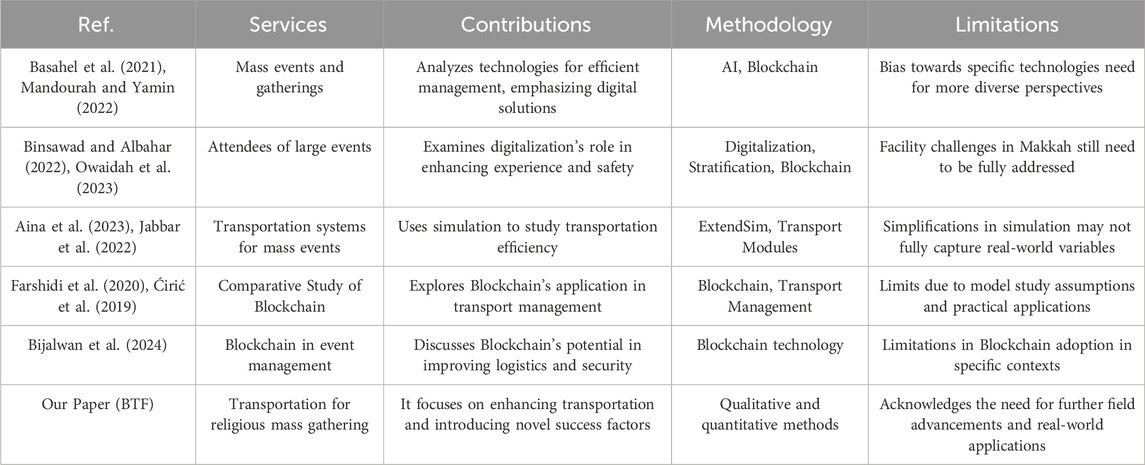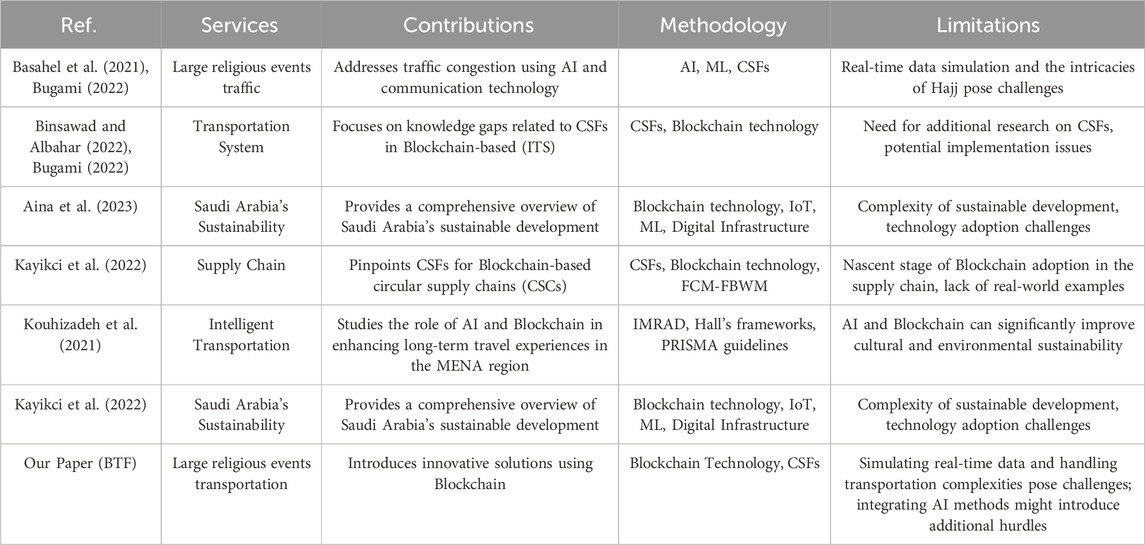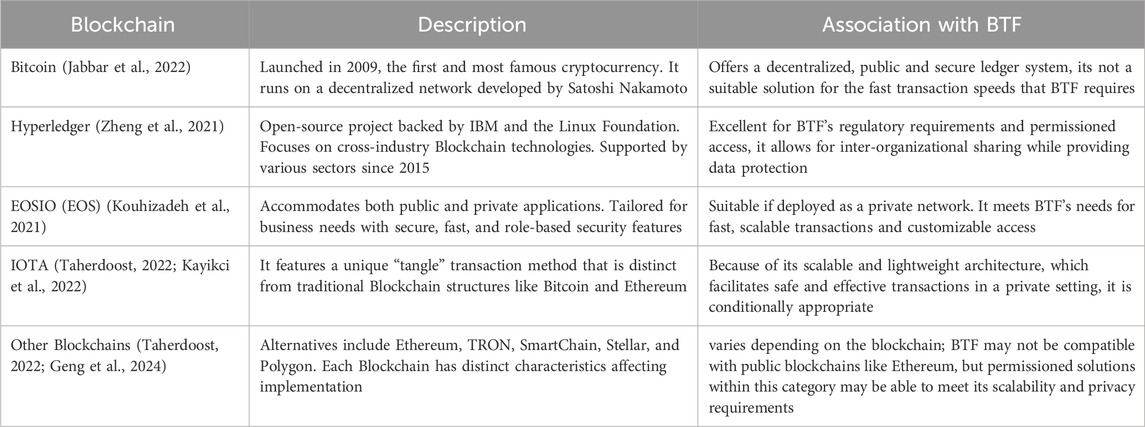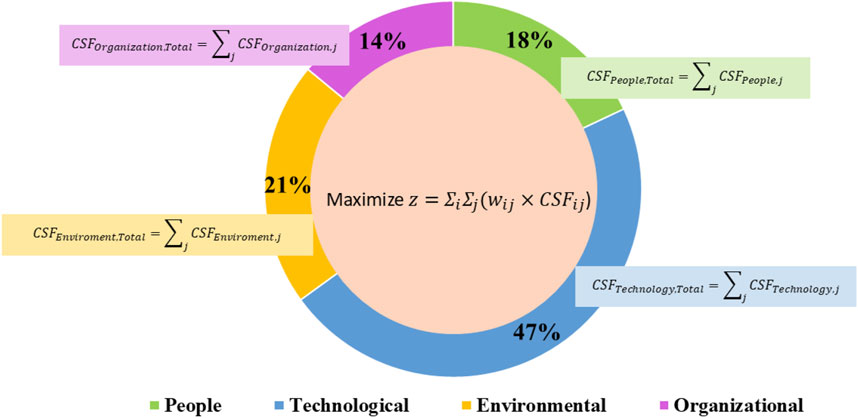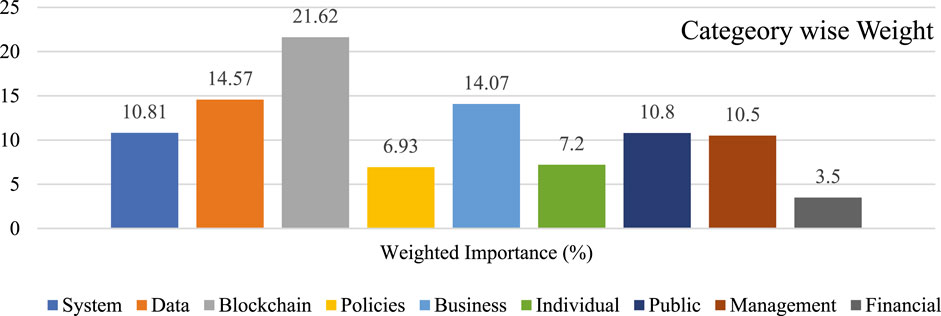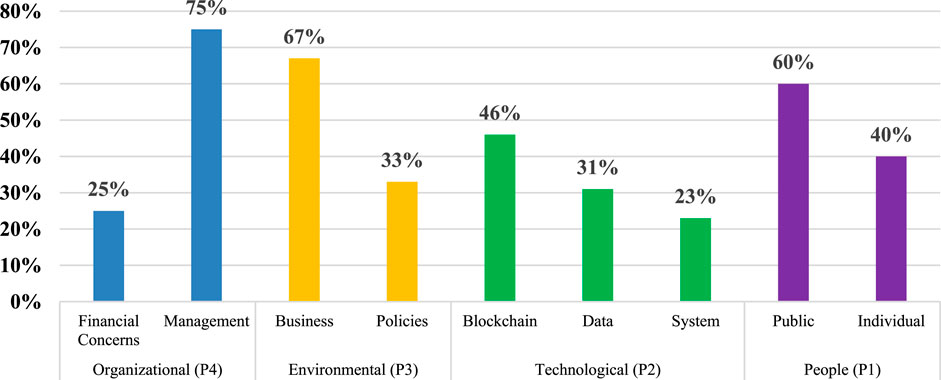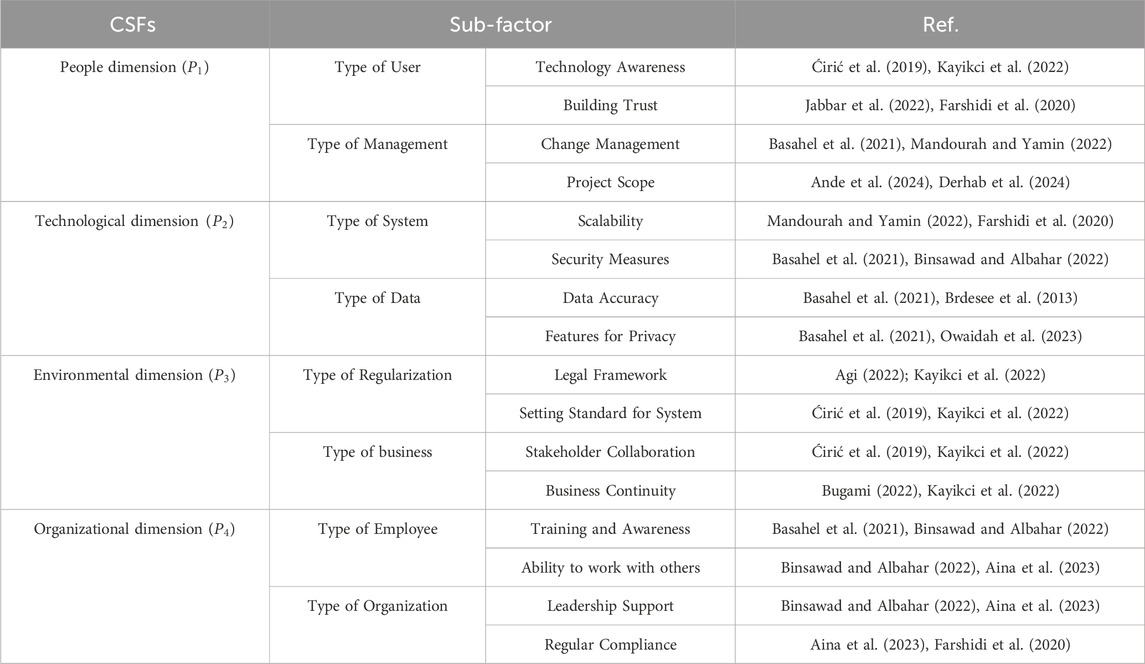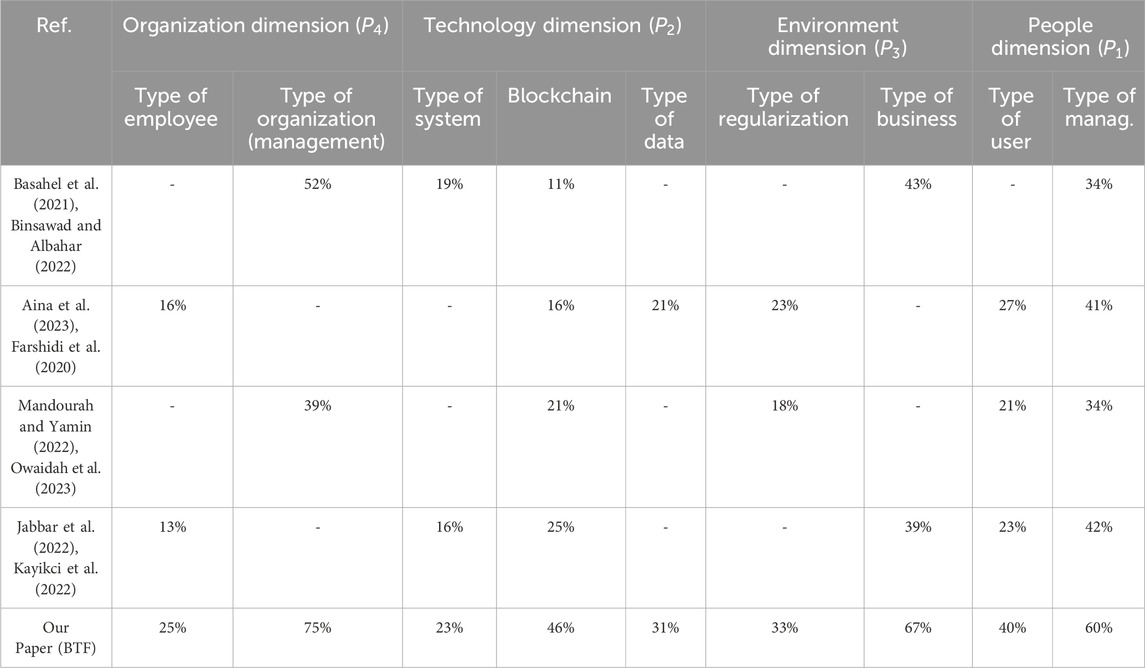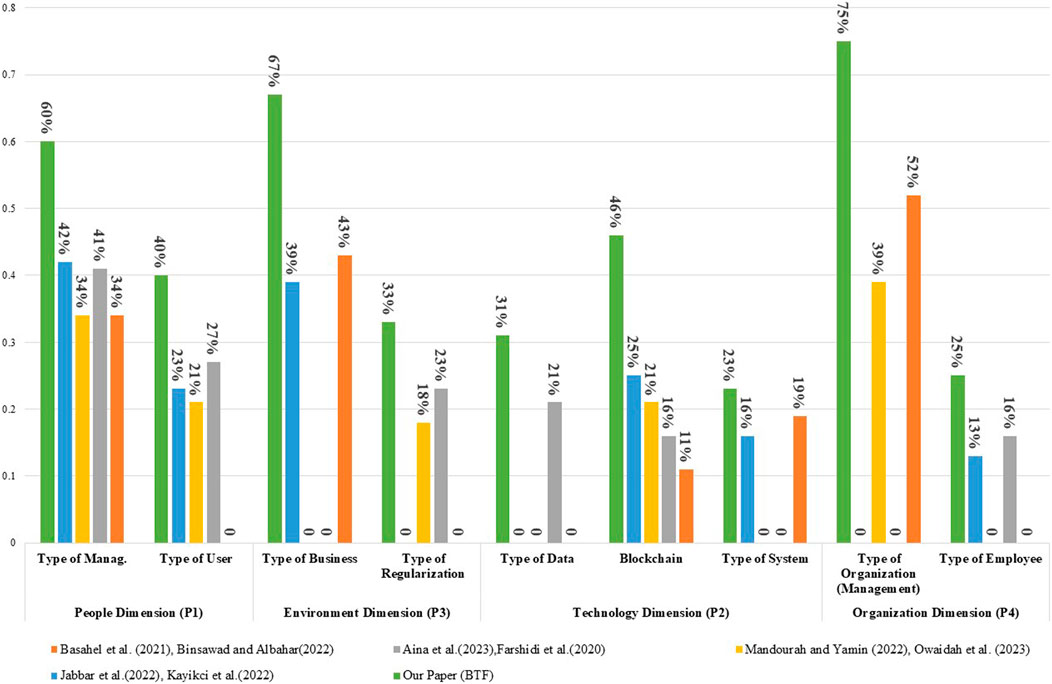- 1Department of Information Systems, Faculty of Computing and Information Technology, King Abdulaziz University, Jeddah, Saudi Arabia
- 2Information Systems Department, Faculty of Computing and Information Technology, King Abdulaziz University, Jeddah, Saudi Arabia
- 3Department of Computer Systems Engineering, Mehran University of Engineering and Technology, Jamshoro, Pakistan
- 4FAST School of Computing, National University of Computer and Emerging Sciences (FAST-NUCES), Karachi, Pakistan
This study examines the incorporation of blockchain technology into Saudi Arabia’s Intelligent Transportation Systems (ITS), concentrating on enhancing the bus permission procedure for religious mass gatherings in Makkah. The research illustrates how blockchain might improve the security and operational effectiveness of transportation management for major events. The research used a weighted significance methodology and Decision-Making Trial and Evaluation Laboratory (DEMATEL) analysis to identify the critical success factors (CSFs) influencing transportation at religious events. The research illustrates the strong interrelation of the CSFs, emphasizing the notable enhancement in transparency and efficiency in the approval and management processes using blockchain-based solutions. The research examines the impact of reformulated CSFs on the proposed blockchain-based transportation framework (BTF), emphasizing key domains such as people (
1 Introduction
Large religious mass gatherings, such as those in Saudi Arabia, where millions of people converge quickly, demand efficient transportation management for their success. However, huge events face complex logistical challenges requiring efficient crowd movement. The current traffic management systems in Saudi Arabia must be improved to mitigate these challenges, providing persistent bottlenecks, congestion control, and delay avoidance (Hassija et al., 2021). The congestion slows down the traffic flow and prevents access to emergency routes (Fernandez-Carames and Fraga-Lamas, 2018).
In addition, bus transportation must be efficient in order to move large numbers of passengers between ritual places. However, the registration, inspection, and validation processes in the bus approval process (BAP) continue to operate with limited automation. As a result, inefficiencies and unapproved practices negatively influence trust between service providers and regulatory authorities (Taherdoost, 2022). The researchers provide various solutions, such as emerging technologies, including blockchain, artificial intelligence (AI), and the Internet of Things (IoT) (Khanzada and Shah, 2016). However, they need drastic improvements to counter the available confronts for existing traffic systems (Oladimeji et al., 2023). Even more so, infrastructural limitations bound the effective management of religious mass gatherings (Badshah et al., 2024).
This research proposes a blockchain-enabled framework to improve scalability, security, and transparency in transportation management during religious mass gatherings, specifically addressing the annual event of Hajj. More specifically, it aims to investigate the bus approval processes unique to Hajj, which require a specialized regulatory framework encompassing stringent safety, timing, and logistical requirements due to the high-density conditions of the pilgrimage. Unlike general bus approvals, these processes involve complex oversight to meet the large-scale transport demands specific to Hajj. By examining the role of blockchain technology in optimizing transportation management for such large-scale religious gatherings, this study addresses a critical gap in the literature. It provides a framework to tackle congestion, security, and scalability challenges, ensuring its applicability for both current and future needs like increased scalability, enhanced real-time monitoring and adaptability to emerging technologies.
1.1 Motivations
The objectives of this study are to identify critical factors for successfully implementing a blockchain-based transportation system for major religious events, which involve numerous attendees and complex organizational needs to ensure smooth and efficient operation. The blockchain’s secure, transparent, and decentralized features are leveraged to coordinate services and enhance service quality. In this framework, the features of blockchain such as decentralized and security have been explored and investigated to provide improve service quality.
These religious mass gatherings rely on transportation management, and integrating proposed blockchain technology for the BAP is critical, as shown in Figure 1. User confidence is increased by regulatory compliance, which implies that the blockchain-based transportation system satisfies safety and legal requirements. Blockchain operations require a robust IT infrastructure to be dependable and efficient, adoption and engagement are driven by increasing user acceptance. These components work together to create an organizational culture that encourages all users and helps the transportation system for major religious events run smoothly.
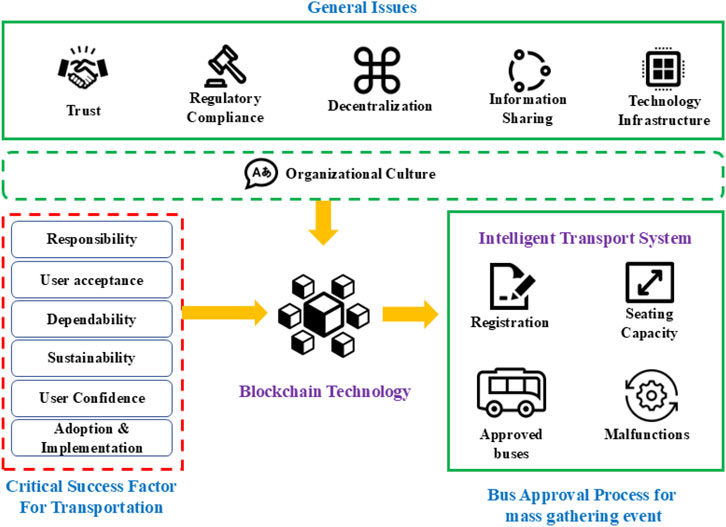
Figure 1. Implementing Blockchain Technology in Transportation management for major religious event approval critical success factors.
By incorporating blockchain into the bus approval system, passenger experience will be enhanced, and it will also enable government authorities to ensure that transport operators adhere to compliance and regulations (Khanzada et al., 2023). The entire framework operates autonomously, with each entity connected in a decentralized manner, improving the efficiency of transportation management during religious events.
1.2 Problem statement for bus approval system (BAS)
The Bus Approval System (BAS) for large religious mass gathering in Saudi Arabia is challenged by critical problems with data security, stakeholder trust, inefficient approval process, strict time deadlines, and security vulnerabilities (Taherdoost, 2022; Zheng et al., 2021; Rabbani et al., 2024). To resolve these problems, blockchain integration is necessary to improve its scalability, security, and transparency.
The current BAS implies several entities, which comprises bus companies, governmental institutions, and the coordinator, all operating in an environment filled with threats like competition, non-compliance, less trust and lack of information. There are several security risks associated with the exchange of bus data between three different stakeholders, each utilized a separate database management system as shown in Figure 2. This fragmentation can cause an increase in the time taken in the approval process, leading towards costly and time-consuming problems in the approval process. This work aims to identify and evaluate CSFs, to establish the relations between these stakeholders, and to rectify and mitigate the challenges that hinder a systematic bus approval process, ensuring conformity to legal provisions.
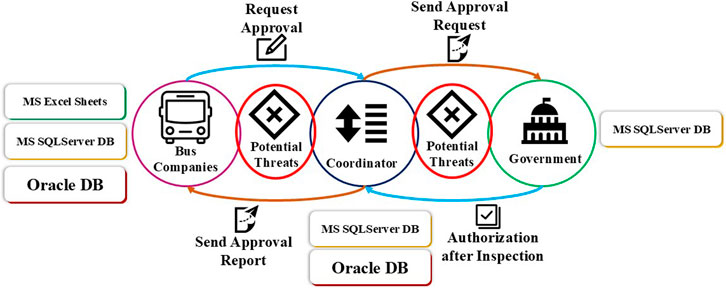
Figure 2. Current Bus Approval Process (Khanzada et al., 2023).
The high traffic of participants is another transport management consideration in the current BAS. Delays, overcrowding, and a lack of accountability are the challenges to effective management due to inadequate structures and systems (Wahab et al., 2018). Integrating blockchain technology will mitigate these challenges by improving the level of transparency, accuracy of data input and process efficiently managing the expectations of stakeholders in order to solve needs is crucial while seeking to build trust with various stakeholders (Farrukh et al., 2022). The work in Nasser et al. (2019), presented that through improving data precision and speeding up decision-making, CSFs based blockchain integration to BAS can facilitate the transportation administration for this mass gathering event.
1.3 Contributions to the research work
The following are the contributions of the proposed work carried out within the current research;
i. Complexity Analysis: Analyze and examine the existing bus approval system used during religious events and demonstrated how blockchain technology can improve it.
ii. Mathematical Model: To support the current proposal about the implementation of blockchain and to clarify its work, the mathematical description is developed.
iii. Transportation Framework Methodology: A new bus approval framework is proposed and intended to deal with existing problems in the existing transportation system.
iv. Systematic Strengthening: Developed a plan of action to implement CSFs designed to improve the efficacy of transportation control system.
These contributions altogether will help in improving the approach of integration and management of transportation systems during religious occasions by using blockchain solutions.
2 Literature review
The following review explores blockchain technology as a transforming industry by exploring its use in improving BAS.
2.1 Blockchain technology
Table 1 summarizes existing research on blockchain applications in different areas. Each study makes unique contributions and employs unique methodologies (Basahel et al., 2021). studied the management of mass events and focus on the role of digital solutions, yet their analysis needs to be more balanced towards some technologies, leaving the bigger picture unexplored. As (Mandourah and Yamin, 2022) confirm, this point is similar to an examination of efficient technology management technologies, there is a limitation in the diversity of the technological view. Additionally (Binsawad and Albahar, 2022), and (Owaidah et al., 2023) are both interested in digitalizing the attendee experience at large events, but neither one of them properly addresses the logistical problems that exist in certain environments, Similar to (Bijalwan et al., 2024), this limitation is mentioned in Agi (2022), discussing the use of blockchain for enhancing logistics and security in event management while highlighting the barriers to adoption in some settings.
Moreover (Aina et al., 2023), and (Jabbar et al., 2022) also simulate transportation efficiency in mass events transportations. But both studies admit the simplifications that support their findings, which are not sufficient to address real-world complexities. Furthermore, the model studies of Farshidi et al. (2020) are limited by the assumptions contained within their model study, it is needed to deploy the Blockchain system based on the CSFs in order to enhance the efficiency of the legacy systems. The current research in this study concentrates familiarizing new success factors with the combination of qualitative and quantitative methods.
2.2 CSFs for Implementing Blockchain Technology
CSFs across various services, particularly for transportation systems have been exploited by various researchers to address blockchain based solutions highlighting sustainability efforts. Various methodologies from artificial intelligence (AI), machine learning (ML), and blockchain technology are highlighted in recurrent studies, which tackle raised challenges inside large-scale transportation operations. Table 2 provides an overview of existing research on CSFs-based blockchain systems in the transportation domain, comparing these studies with the proposed BTF. For instance (Basahel et al., 2021; Bugami, 2022), and (Bugami, 2022) focus on traffic congestion management, while (Bijalwan et al., 2024) explores travel experience in the Middle East and North Africa (MENA) region. This comparison of services, contributions, methodologies, and limitations offers a foundation for reformulating CSFs within the transportation system, supporting the development of a blockchain framework to address current challenges effectively.
Further (Binsawad and Albahar, 2022), and (Bugami, 2022) focus to fill knowledge gaps related to CSFs and (Kayikci et al., 2022) discuss the complexity of sustainable development. All these conclude to blockchain solution based on optimally reformulated CSFs, will enhance the efficiency and trustworthiness of the implemented system. It is therefore, needed to deploy an optimally formulated CSFs based blockchain solution to mitigate the highlighted issues encountered by the mass level transportation system. This research presents CSFs based innovative solutions for large religious event transportation using Blockchain technology. It is worthy to note that the key CSFs improve making operations smoother during these events.
Investigating CSFs for the adoption of blockchain technology in transportation control, targeting bus approval during large-scale religious gathering is being worked out in our model. It aims to improve transportation efficiency and effectiveness in blockchain based transportation systems. We also provide an overview of the blockchain based systems overview in Table 3.
3 Methodology
This research develops a comprehensive framework called BTF to mitigate the highlighted issues raised in Section 1. BTF is based on the determination of the CSFs. This study used a mixed-methods approach, analyzing articles from 2010 to 2024 and collecting primary data through questionnaires with government representatives, transportation managers, and IT specialists. This approach ensures a thorough analysis of blockchain implementation in transportation management.
The first process is the design phase, which involves a comprehensive bibliographic review. The design incorporates feedback from multiple sources, such as government departments, transport organizations, and the coordinator. The second phase of the framework deals with the identification of technology by evaluating various blockchain systems, investigating accommodation capacity for various numbers of users, the level of security, and their integration.
The suggested blockchain-based architecture for the BAS is depicted in Figure 3, highlighting its main architectural advantages that improve stakeholder synchronization, data security, and transparency. By incorporating permissioned blockchain protocols, enhancing transparency via real-time data sharing, and preserving synchronization across all involved organizations, the framework ensures secure data transfers.
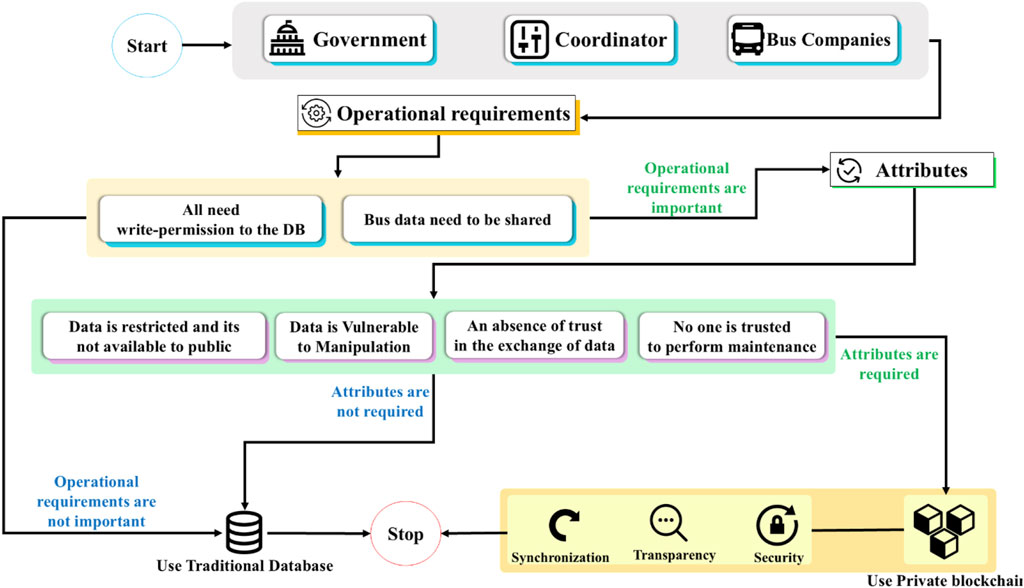
Figure 3. Decision-making framework for selecting either a private blockchain or traditional database for BAS.
The framework also includes a comprehensive assessment of the CSFs that are derived and vital for the effective implementation of the BTF. During pilot implementation stages, surveys and feedback loops are created to capture information that is utilized to improve and adapt the framework. The iterative solutions guarantee that the BTF is adaptive to stakeholder considerations and technological advances. These technological improvements enable the system to process more transactions through the volume capacity without necessarily reducing efficiency and security rates.
The integration of new CSFs based rules ensures that the framework complies with data privacy laws in various regions while, at the same time, strengthening stakeholder confidence in the system. The next section discussed the data collection during the implementation of the proposed model BTF.
The process of identifying CSFs and their subsequent validation requires a holistic and complex approach. Existing CSFs recouped from literature delve inadequate implementation, lack competency, and are comprising deficiency to be part of successful BAS implementation. We have integrated secondary analysis of publications with primary data obtained from interviews with government officials, transportation managers, and IT professionals, so assuring a thorough examination of blockchain deployment in transportation management.
Our proposed methodology eliminates these shortcomings and provides new categorization of CSFs into four key dimensions: These are people (

Table 4. Comparative analysis of dimension derivation and methodological contributions in blockchain-based BAS.
Based on their crucial importance to the effective deployment of blockchain-based transportation frameworks, we chose the four dimensions—people (
Each dimension represents an important aspect of system functionality: people manage user adoption and behavior variables, organizations focus on strategy alignment and resource allocation, technology signifies scalability and security, and the environment dimension takes social and regulatory issues into account.
Each dimension’s sub-categories were developed to capture the specific needs required to address the BAS, as confirmed by comparison with literature studies and feedback from transportation managers, IT professionals’ response. With this methodical approach, a robust framework that is adapted to the particular requirements for religious mass gatherings is presented.
Our framework substantiates these CSFs through comprehensive research and practical utilization, providing a solid foundation for the application of blockchain technology (Naikwadi et al., 2021; Zhang, 2022). Based on these CSFs, we build a solid foundation for the implementation of blockchain-based transportation systems that may provide solutions to defeat the challenges associated with managing transportation during large religious events. Figure 4 illustrates a step-by-step methodology for the formulated BTF. The mathematical model for our developed framework is discussed in the following section.
3.1 Mathematical model
The integration of the BTF into the BAS involves an analysis of CSFs across the four dimensions outlined above, which are essential for managing transportation systems during large-scale events. Table 4 compares the dimensions—people
The identified issues with blockchain and its application in transportation and logistics by our new CSFs have a well-structured solution to the issues arising due to its integration in complex transportation systems. The model categorizes CSFs as
A systematic methodology based on the DEMATEL approach and previous research (Grida et al., 2022; Mishra et al., 2023) was used to develop the equations for evaluating CSFs. Equation 1 maximizes the objective function (
Equations 2–5 then evaluate the percentages and cumulative impact of the CSFs across the four dimensions. These equations estimate the total CSF impact for each dimension, represented as
Equation 6 is used as normalization stage by restricting the sum of the weights for all dimensions and sub-categories to 100% (Mishra et al., 2023). This normalization allows for a balanced comparison across different dimensions, aligning each dimension’s impact within a unified framework. Figure 5 illustrates the distribution of these weights and percentages across the four dimensions, highlighting each dimension’s contribution to the total CSF impact.
The mathematical model for the proposed solution involves using blockchain technology to improve decision-making processes for stakeholders and enhance efficiency. This approach aims to provide a safe, efficient, and sustainable transport solution. The framework addresses the CSFs that enable large-scale events and make their management more accessible and better for attendees and coordinators.
3.2 Re-Structuring blockchain implementation for BAS based on CSFs
The effective implementation of the above model uses DEMATEL analysis, which analyzes each CSF with the problems and proposed solutions. This analysis is summarized in Table 5.
By inspecting Table 5, one can observe that the successful implementation of our proposed BAS based on newly derived CSFs validated the DEMATEL analysis. Implementing these aspects allows for enhancement of the Saudi Arabia transportation infrastructure, providing enhanced effectiveness, openness, and contingency throughout the massive religious pilgrimages.
4 Analysis and findings
4.1 Evaluation of performance metrics of CSFs based BAS
In this section, we evaluate our derived model BTF based on newly derived CSFs. We evaluate the performance metrics for CSFs that improve the integrity of the transactions, security, and reliability. CSFs have high visibility, enhancing data openness, accessibility, and the quality of user experience. We have evaluated the performance impact of implementing each CSF dimension and its subcategories. Table 6 shows the significant contribution for each CSF and its subcategory.
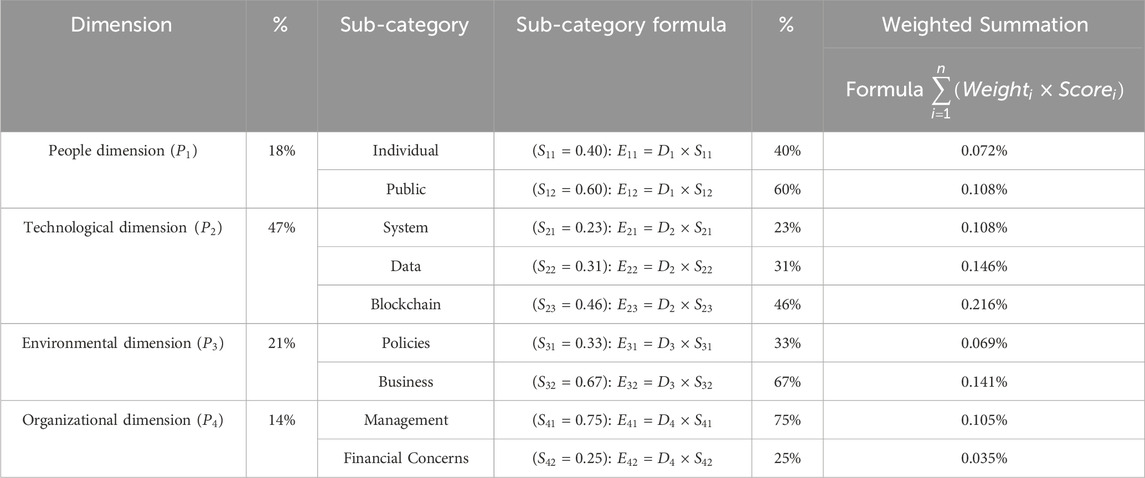
Table 6. Comprehensive Quantitative Analysis of all dimensions, Sub-categories with its formulas and Weighted Summation Impact.
The above approach directly fulfills the gaps in the proposed framework. The subscripts ind, pub, sys, data, bc, pol, bsn, mng, and fin, represent the individual, public, system, data, blockchain, policies, business, management, and financial sub-categories of the CSFs respectively. This method ensures a nuanced understanding of each sub-category’s role within its broader dimension. Furthermore, we can derive the respective effects in sequel as
The estimation performance impact using above formulation for each sub-category is summarized in Table 6, where the legends,
A systematic and tiered analysis with this algebraic derivation provides the impact of each sub-category. The largest percentages reflect the high impact and greater relative influence, while the smallest percentages mimic the weakest impact within the framework. An effective established weighted significance within these sub-categories creates a robust context for assessing and ranking CSFs in BTF. This weighted importance is given in Equation 7, Zafar et al. (2021), Ilieva et al. (2021).
Equations 7, 8 are based on approaches addressed in previous studies, such as (Zafar et al., 2021; Ilieva et al., 2021). These studies analyze the relative importance of criteria in blockchain systems using DEMATEL methodologies and weighted scoring models. Developing these concepts further, we adapted the formulas to meet the unique requirements of BTF, enabling a systematic evaluation of the CSFs.
The weighted summation value for each sub-category, calculated using Equation (8), is visually represented in Figure 6. Within the technological dimension
Figure 7 and Table 6 show further analysis for the breakdown of the importance level in terms of the dimensions and subcategories identified. Technology is the largest, with 47%, where the major contribution is by blockchain at 46%, showing its importance. The environmental dimension is next at 21% it concerns sustainability. The people dimension, which accounts for 18%, contrasts the social and personal aspects of the company. The organizational dimension, which accounts for 14%, emphasizes the concern of management practices over money. As seen from the breakdown, there are disparities in the focus and difficulties that may come about while developing blockchain-based transportation systems for huge religious events.
Table 7 illustrates an analysis of the CSFs dimensions and sub-factors for the bus approval process.
4.2 Analysis of organizational, technological, environmental, and people dimension
The structure of the contemporary business environment is characterized by new technologies, new organizational forms, a constantly changing environment, and people. Knowledge of these dimensions enables informed decisions and fosters sustainable development. The following Table 8 organizes the findings from cited studies against the findings of this study in terms of organizational, environmental, and human antecedents.
This research stipulates that blockchain implementations in modern organizations with reference to organizational, technical, environmental, and human factors require a high impact CSFs based system. Findings reveal that organizational dimension features are personnel types and financial resources are significant. With regard to technology, CSFs attributed to management systems and blockchain range from 39% to 75%. The environmental component is characterized by data management and adherence issues and may consume between 11 and 46 percent of CSFs. The personnel dimension is also important and has user engagement and management participation contributing to CSFs ranging between 27% and 60%. As shown in Figure 8, the employee type of organization is more relevant in 25% of organizational CSFs, and for technology, the system type is highly important at 75%. Finally, the research highlights the implications of the examined factors for the proper application of blockchain logistics in large religious events.
4.3 Comparison of impact of deployed CSFs for BTF with the legacy CSFs
The transition from Microsoft SQL Server and Oracle databases to a permissioned blockchain system, guided by CSFs, was evaluated based on integrity, efficiency, scalability, accuracy, and reliability. Analysis implies that blockchain technology provides enhanced security and transparency, notably increasing control over transportation management during large-scale events, such as religious mass gatherings. Data from system logs, transactions, and user inputs were collected before and after implementation, with automated scripts facilitating efficient data collecting. A subsequent rigorous study confirmed that shifting from centralized databases to a permissioned blockchain system substantially enhanced integrity, efficiency, scalability, accuracy, and dependability, showing effective in reinforcing data integrity and transparency while keeping reliable monitoring. Table 9 illustrates a comparative outline of pre- and post-implementation indicators.
They addressed issues such as data tampering and decreased the time taken for a transaction from 5 to 1–3 s. The system can process more transactions since transaction throughput is now at 3,500 Tera Byte per second (TPS) when it used to be 800 TPS. Reconciliation errors were reduced from 25 to 1 per month, while system availability increased from 93% to between 99.5% and 99.9%, suggesting enhanced system stability and reliability over time. These gains demonstrate that the permissioned blockchain can enhance performance and reliability, particularly for transportation during significant events. Table 9 and Figure 9 show that blockchain enhances the following characteristics: integrity, efficiency, scalability, accuracy, and reliability.
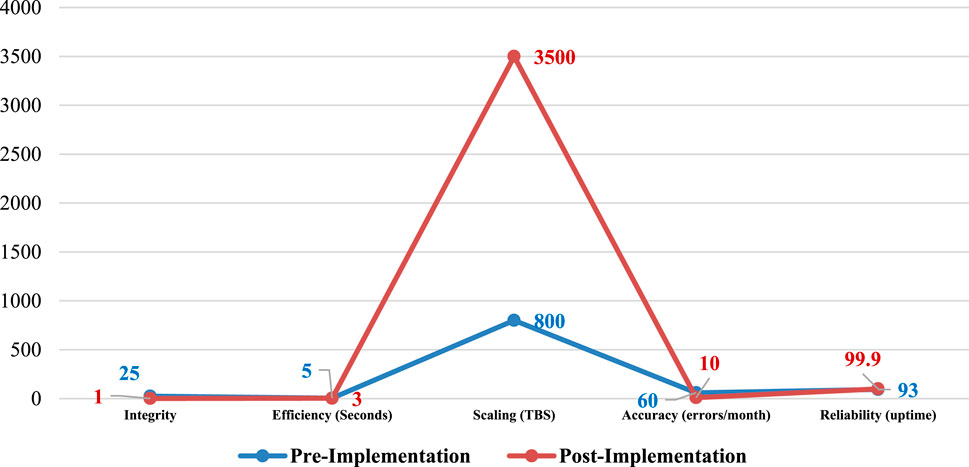
Figure 9. Performance Improvement Analysis for Transition from centralized databases to permissioned blockchain system.
4.4 Impact of deployed CSFs (for BTF) on performance metrics
Figure 10, a stacked bar chart, presents the impact of different CSFs on the performance indicators. Hence, by using different colors for each CSF, the chart directly compares the previously mentioned aspects and highlights the fields that need a strategic push. At the same time, it stresses the interdependency of those factors in creating an effective, expansive, and fault-tolerant blockchain-based transportation system for religious mass gathering.
Using the chart, CSFs for the BAS can be assessed with respect to stakeholder involvement, environmental implications, legal requirements, etc. The Y-axis illustrates the value added by CSFs to performance metrics such as integrity, efficiency, scalability, accuracy, and reliability, all of which have been rated on a scale of 0–10. The X-axis labels all factors by their impact score, with a cumulative inherent score that raises awareness on which aspects improve systems’ efficiency, security, and reliability in handling vast religious events. They identify the legal issues that influence integrity and reliability most, and user acceptance must precede pilot testing. In particular, it demonstrates that a permissioned blockchain system can solve the high transaction volume and enhance the transport management for large events, and hence, the CSFs proposed in this paper should be implemented.
5 Discussion
CSFs analysis reveals aspects influencing the feasibility of a blockchain-based transportation architecture for mass gatherings in Saudi Arabia. According to the above distribution, the most dominant distribution in CSFs is the technological dimension at 47%. Blockchain has the highest overall weighted summation impact of 46% by differentiated relevance and frequency. The above results demonstrate how the use of the blockchain system enhances the efficiency of the system and the accuracy of recorded information. The organizational dimension is at 14% and is centered on management structures and finances with slightly less significance than those of technology. It is therefore clear that for the environmental and the people components which at 21% and 18% respectively inform policy direction and formulation, and acceptance and conduct to ensure operations are not hampered require formulation of polices that can easily be accepted.
Assessment of the indicators before and after blockchain implementation confirms this technology’s value in future transportation networks. Thus, the implementation decreases cases of data tampering from 25 monthly cases to none-1 and enhancing the throughput from 800 TPS to 3,500 TPS. The implementation also reduced the possibility of reconciliation errors and the system availability was raised to between 99.5% and 99.9%. The conclusions suggest that applications of blockchain enhance the availability of the transportation systems in handling religious mass gatherings, aside from achieving security and optimization goals. The study therefore propounds the success factors for the block chain application in Saudi Arabia’s transport sector to provide the best and most credible solutions.
6 Limitations and practitioner implications
The identified CSFs may not apply universally across different contexts, and the research is more focused on a specific region and a unique mass gathering event. Additionally, factors such as technology readiness, infrastructure constraints, and end-user acceptance were not thoroughly examined. Future research should address these aspects and explore the long-term sustainability of blockchain in diverse cultural and operational environments.
For practitioners, this research offers valuable insights. Blockchain can enhance not only the organization and safety of transportation at mass gathering events but also increase the trust of transport authorities, passengers, and service providers. By testing and adopting blockchain technologies, practitioners can achieve a more reliable logistics system tailored to those events. It is crucial for stakeholders to collaborate in managing implementation challenges to fully realize the benefits of blockchain in transportation management within Saudi Arabia.
7 Conclusion and future work
In conclusion, this study demonstrates the significant potential of blockchain technology to enhance transportation systems during religious mass gathering events in Makkah. The findings indicate that weighted significance and DEMATEL analysis are effective in identifying CSFs for successful implementation. Our analysis evaluated the impact of the reformulated CSFs within the proposed BTF, revealing that the blockchain CSFs achieved the highest impact score of (21.62), while the financial CSF had the lowest impact at (0.25). These results show that blockchain can address key challenges, including data security, reconciliation errors, and transaction inefficiencies, fostering a more secure and efficient transportation framework. The proposed mathematical model serves as a guiding framework, facilitating the integration of blockchain to optimize performance in large-scale transport scenarios. Future research could explore the model’s application in different contexts and further refine the identified CSFs for broader applicability.
Data availability statement
The datasets generated during and/or analyzed during the current study are available from the corresponding author on reasonable request, subject to privacy and confidentiality agreements.
Author contributions
AM: Conceptualization, Data curation, Formal Analysis, Funding acquisition, Investigation, Methodology, Project administration, Resources, Software, Supervision, Validation, Visualization, Writing–original draft, Writing–review and editing. TK: Conceptualization, Investigation, Methodology, Supervision, Validation, Visualization, Resources, Project administration, Writing–review and editing. MS: Conceptualization, Investigation, Methodology, Supervision, Validation, Visualization, Resources, Project administration, Writing–review and editing.
Funding
The author(s) declare that no financial support was received for the research, authorship, and/or publication of this article.
Conflict of interest
The authors declare that the research was conducted in the absence of any commercial or financial relationships that could be construed as a potential conflict of interest.
Publisher’s note
All claims expressed in this article are solely those of the authors and do not necessarily represent those of their affiliated organizations, or those of the publisher, the editors and the reviewers. Any product that may be evaluated in this article, or claim that may be made by its manufacturer, is not guaranteed or endorsed by the publisher.
References
Agi, M. A. N. (2022). Understanding the enablers of blockchain technology adoption in sustainable supply chains: a DEMATEL-based analysis. IFAC-PapersOnLine 55, 1962–1967. doi:10.1016/j.ifacol.2022.09.686
Aina, Y. A., Abubakar, I. R., Almulhim, A. I., Dano, U. L., Maghsoodi Tilaki, M. J., and Dawood, S. R. S. (2023). Digitalization and smartification of urban services to enhance urban resilience in the post-pandemic era: the case of the pilgrimage city of makkah. Smart Cities 6, 1973–1995. doi:10.3390/smartcities6040092
Ande, D. F., Wahyuni, S., and Kusumastuti, R. D. (2024). Investigating the impact of service leaders’ competencies, organisational service orientation, network capabilities, and perceived service quality on Umrah travel agencies’ performance. J. Islamic Mark. 15, 653–681. doi:10.1108/JIMA-06-2022-0185
Badshah, A., Abbas, G., Waqas, M., Muhammad, F., Abbas, Z. H., Bilal, M., et al. (2024). Blockchain-assisted lightweight authenticated key agreement security framework for smart vehicles-enabled intelligent transportation system. IEEE Trans. Automation Sci. Eng. 21, 2425–2439. doi:10.1109/TASE.2024.3381068
Basahel, S., Alsabban, A., and Yamin, M. (2021). Hajj and umrah management during COVID-19. Int. J. Inf. Technol. 13, 2491–2495. doi:10.1007/s41870-021-00812-w
Bijalwan, J. G., Singh, J., Ravi, V., Bijalwan, A., Alahmadi, T. J., Singh, P., et al. (2024). Navigating the future of secure and efficient intelligent transportation systems using AI and blockchain. Open Transp. J. 18. doi:10.2174/0126671212291400240315084722
Binsawad, M., and Albahar, M. (2022). A technology survey on IoT applications serving umrah and Hajj. Appl. Comput. Intell. Soft Comput. 2022, 1–10. doi:10.1155/2022/1919152
Brdesee, H., Corbitt, B., and Pittayachawan, S. (2013). Barriers and motivations affecting Information Systems usage by Hajj–Umrah religious tourism operators in Saudi Arabia. Australas. J. Inf. Syst. 18, 18. doi:10.3127/ajis.v18i1.809
Bugami, M. A. (2022). “Saudi arabia’s march towards sustainable development through innovation and technology,” in 2022 9th International Conference on Computing for Sustainable Global Development (INDIACom), New Delhi, India, 23-25 March 2022 (IEEE), 01–06. doi:10.23919/INDIACom54597.2022.9763172
Ćirić, Z., Sedlak, O., and Ivanišević, S. (2019). Identification of critical success factors for the implementation of the blockchain projects in the smart cities. 129–133. doi:10.31410/LIMEN.2019.129
Derhab, A., Mohiuddin, I., Halboob, W., and Almuhtadi, J. (2024). Crowd congestion forecasting framework using ensemble learning model and decision making algorithm: umrah use case. IEEE Access 12, 67453–67469. doi:10.1109/ACCESS.2024.3394905
Farrukh, M., Syed, M. F., Khanzada, T. J. S., and Khan, A. (2022). Automatic jammer signal classification using deep learning in the spectrum of ai-enabled cr-iot network. 7th International congress on information and communication technology.
Farshidi, S., Jansen, S., Espana, S., and Verkleij, J. (2020). Decision support for blockchain platform selection: three industry case studies. IEEE Trans. Eng. Manag. 67, 1109–1128. doi:10.1109/TEM.2019.2956897
Fernandez-Carames, T. M., and Fraga-Lamas, P. (2018). A review on the use of blockchain for the Internet of Things. IEEE Access 6, 32979–33001. doi:10.1109/ACCESS.2018.2842685
Geng, X., Wen, Y., Mo, Z., Dong, P., Kong, F., and Xiong, K. (2024). On the evaluation framework of comprehensive trust for data interaction in intermodal transport. Electron. (Basel) 13, 1487. doi:10.3390/electronics13081487
Grida, M. O., Abd Elrahman, S., and Eldrandaly, K. A. (2022). Critical success factors evaluation for blockchain’s adoption and implementing. Systems 11, 2. doi:10.3390/systems11010002
Hassija, V., Zeadally, S., Jain, I., Tahiliani, A., Chamola, V., and Gupta, S. (2021). Framework for determining the suitability of blockchain: criteria and issues to consider. Trans. Emerg. Telecommun. Technol. 32, 32. doi:10.1002/ett.4334
Huang, J., Kong, L., Kong, L., Liu, Z., Liu, Z., and Chen, G. (2018). “Blockchain-based crowd-sensing system,” in 2018 1st IEEE International Conference on Hot Information-Centric Networking (HotICN), Shenzhen, China, 15-17 August 2018 (IEEE), 234–235. doi:10.1109/HOTICN.2018.8605960
Ilieva, G., Yankova, T., Radeva, I., and Popchev, I. (2021). Blockchain software selection as a fuzzy multi-criteria problem. Computers 10, 120. doi:10.3390/computers10100120
Jabbar, R., Dhib, E., Said, A. B., Krichen, M., Fetais, N., Zaidan, E., et al. (2022). Blockchain technology for intelligent transportation systems: a systematic literature review. IEEE Access 10, 20995–21031. doi:10.1109/ACCESS.2022.3149958
Kayikci, Y., Gozacan-Chase, N., Rejeb, A., and Mathiyazhagan, K. (2022). Critical success factors for implementing blockchain-based circular supply chain. Bus. Strategy Environ. 31, 3595–3615. doi:10.1002/bse.3110
Khanzada, T. J. S., Shahid, M. F., Mutahhar, A., Aslam, M. A., Ashari, R. B., Jamal, S., et al. (2023). Authenticity, and approval framework for bus transportation based on blockchain 2.0 technology. Appl. Sci. 13 (20), 11323. doi:10.3390/app132011323
Khanzada, T. J. S., and Shah, S. F. (2016). Realizing cognitive radio technology for wireless sensor networks. Emerging Communication Technologies Based On Wireless Sensor Networks: Current Research And Future Applications.
Kouhizadeh, M., Saberi, S., and Sarkis, J. (2021). Blockchain technology and the sustainable supply chain: theoretically exploring adoption barriers. Int. J. Prod. Econ. 231, 107831. doi:10.1016/j.ijpe.2020.107831
Mandourah, A., and Yamin, M. (2022). “Using blockchain technology to manage Hajj and umrah,” in 2022 9th International Conference on Computing for Sustainable Global Development (INDIACom), New Delhi, India, 23-25 March 2022 (IEEE), 870–875. doi:10.23919/INDIACom54597.2022.9763210
Mishra, R., Singh, R. K., Kumar, S., Mangla, S. K., and Kumar, V. (2023). Critical success factors of Blockchain technology adoption for sustainable and resilient operations in the banking industry during an uncertain business environment. Electron. Commer. Res. doi:10.1007/s10660-023-09707-3
Naikwadi, B. H., Kharade, K. G., Yuvaraj, S., and Vengatesan, K. (2021). A systematic review of blockchain technology and its applications. Adv. Parallel Comput. doi:10.3233/APC210230
Nasser, N., el Ouadrhiri, A., el Kamili, M., Ali, A., and Anan, M. (2019). “Crowd management services in Hajj: a mean-field game theory approach,” in 2019 IEEE Wireless Communications and Networking Conference (WCNC), Marrakesh, Morocco, 15-18 April 2019 (IEEE), 1–7. doi:10.1109/WCNC.2019.8886019
Oladimeji, D., Gupta, K., Kose, N. A., Gundogan, K., Ge, L., and Liang, F. (2023). Smart transportation: an overview of technologies and applications. Sensors 23, 3880. doi:10.3390/s23083880
Rabbani, H., Shahid, M. F., Khanzada, T. J. S., Siddiqui, S., Jamjoom, M. M., Ashari, R. B., et al. (2024). Enhancing security in financial transactions: a novel blockchain-based federated learning framework for detecting counterfeit data in fintech. PeerJ Comput. Sci. 10, e2280. doi:10.7717/peerj-cs.2280
Owaidah, A., Olaru, D., Bennamoun, M., Sohel, F., and Khan, N. (2023). Transport of pilgrims during Hajj: evidence from a discrete event simulation study. PLoS One 18, e0286460. doi:10.1371/journal.pone.0286460
Taherdoost, H. (2022). A critical review of blockchain acceptance models—blockchain technology adoption frameworks and applications. Computers 11, 24. doi:10.3390/computers11020024
Wahab, S., Saifullah, T. J., Mansoor, M., Abro, S. A., and Raza, A. (2018). A novel approach towards traffic monitoring system using adhoc networking.
Zafar, S., Alamgir, Z., and Rehman, M. H. (2021). An effective blockchain evaluation system based on entropy-CRITIC weight method and MCDM techniques. Peer Peer Netw. Appl. 14, 3110–3123. doi:10.1007/s12083-021-01173-8
Zhang, W. (2022). Analysis on potential blockchain applications in finance, sports, and supply chain management. Adv. Econ. Bus. Manag. Res., 1528–1532. doi:10.2991/978-94-6463-036-7_227
Keywords: blockchain technology, CSFs, mass event transportation, decentralized authority, security in transportation
Citation: Mutahhar AY, Khanzada TJS and Shahid MF (2025) Analyzing critical success factors using blockchain based framework for intelligent transportation systems. Front. Blockchain 7:1443207. doi: 10.3389/fbloc.2024.1443207
Received: 03 June 2024; Accepted: 21 November 2024;
Published: 03 January 2025.
Edited by:
Charalampos Alexopoulos, University of the Aegean, GreeceCopyright © 2025 Mutahhar, Khanzada and Shahid. This is an open-access article distributed under the terms of the Creative Commons Attribution License (CC BY). The use, distribution or reproduction in other forums is permitted, provided the original author(s) and the copyright owner(s) are credited and that the original publication in this journal is cited, in accordance with accepted academic practice. No use, distribution or reproduction is permitted which does not comply with these terms.
*Correspondence: Ahmad Yahya Mutahhar, YWhtZWQubXV0YWhlckBnbWFpbC5jb20=
†ORCID: Ahmad Yahya Mutahhar, orcid.org/0009-0007-5821-2523; Tariq Jamil Saifullah Khanzada, orcid.org/0000-0003-1617-4403; Muhammad Farrukh Shahid, orcid.org/0009-0004-8787-1868
 Ahmad Yahya Mutahhar
Ahmad Yahya Mutahhar Tariq Jamil Saifullah Khanzada
Tariq Jamil Saifullah Khanzada Muhammad Farrukh Shahid
Muhammad Farrukh Shahid